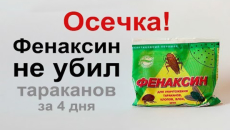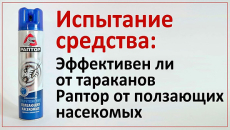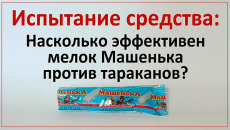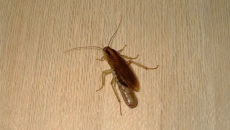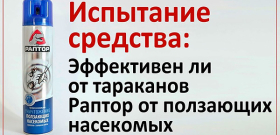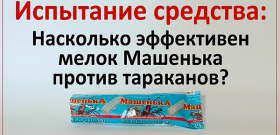During the experiment, we tested the Phenaksin insecticidal powder on ordinary red cockroaches - and the product did not work. For four whole days we waited for the insects, being in a plastic container with powder, to die, but not a single cockroach was poisoned.
Watch video:
0:08 - Basic information about Phenaksin and the main factors that determine its popularity in the fight against cockroaches: the tool is inexpensive, easy to use, affordable to purchase and relatively safe for humans. In addition, Phenaksin is also positioned as a convenient tool for dealing with bed bugs, fleas, ants and some garden pests.
0:21 - We study the composition of Phenaksin. In theory, due to the content of boric acid, the agent should kill even cockroaches that are resistant to other insecticides (insects do not develop resistance to boric acid). However, here you need to understand that the desired effect will be achieved only if the pest deigns to eat the poison, and not just run over it.
0:26 - Another active ingredient of Phenaksin is the pyrethroid fenvalerate.
0:32 – Comments on the effect of fenvalerate on insects. Is Phenaksin able to have a contact poisoning effect?
1:21 - The mechanism by which boric acid poisons insects. Why is resistance not being developed to this substance?
2:25 - The concentration of active ingredients in the preparation. The mass of the product in one bag is 125 grams.
3:06 - Places in the apartment where, according to the instructions for use, it is advisable to scatter the product so that it effectively poisons insects.
3:53 - Pour a small amount of Phenaksin into a plastic container. At the same time, areas free of powder remain at the bottom of the container - this is how we simulate the conditions in an ordinary apartment, in which cockroaches will only occasionally run through the facility.During the experiment, we use less than 1 gram of powder.
4:28 - We put a few cockroaches in the container. They took two adults (female and male), as well as two nymphs.
4:38 - We note the time, then to see how quickly the insects begin to die from the action of the agent.
4:55 - The female is already thoroughly soiled in powder (which means that there is reason to assume that she will die faster than other relatives).
5:47 - We put a piece of bread and cotton wool moistened with drinking water in a plastic container. In practice, it is desirable to eliminate sources of food and water from the premises when using the product, but in fact, doing this at home is often problematic - there is still at least some food and some water for cockroaches. Therefore, we simulate normal home conditions, when there will certainly be access to food and water.
6:32 - After 12 hours from the start of the test, all insects are alive, they do not show signs of poisoning. At the same time, all the cockroaches got dirty in the dust and soiled the bread with them. Thus, contact with the insecticide has occurred, and we only have to estimate when the poisoning effect will manifest itself.
7:16 - A full 24 hours have passed since the beginning of the experiment. All cockroaches in the container are alive and active.
7:28 - We observe how the male drinks water, which is moistened with cotton wool.
7:46 - Two days after the start of the experiment, not a single cockroach in the container died.
8:10 - We change the bread for fresher and re-moisten the cotton with water.
8:33 - 4 days have passed since the cockroaches were placed in the container.All of them are alive and moving.
9:02 – Summary: specifically in the experiment, Phenaksin did not lead to the poisoning of cockroaches and did not affect them at all. Why this result is obtained is not clear. It is possible that the test individuals are resistant to the action of fenvalerate, and the effect of boric acid was not manifested, since the cockroaches did not eat too much of it (plus there was a weakening of the effect due to the constant consumption of water by insects).
9:51 - Perhaps the amount of insecticides in the product is too low, and this is not enough to effectively kill insects. For example, in the fight against cockroaches, boric acid is often used in its pure form (sometimes it is abundantly mixed into egg yolk), and not at a concentration of 0.25%.
10:26 - Is Phenaksin capable of destroying cockroaches in an apartment if he did not show results during the test? This is not excluded, since the insects in our experiment could have resistance to fenvalerate, while under other conditions they may not have such resistance.
10:52 - It can also be assumed that if cockroaches do not have access to water in an ordinary apartment, they will die from the poisoning effect of boric acid, which is part of Phenaksin.
11:11 - Nevertheless, the result of our particular experiment is as follows: Phenaksin did not work on the test cockroaches (they were caught by the exterminator in the hostel).


